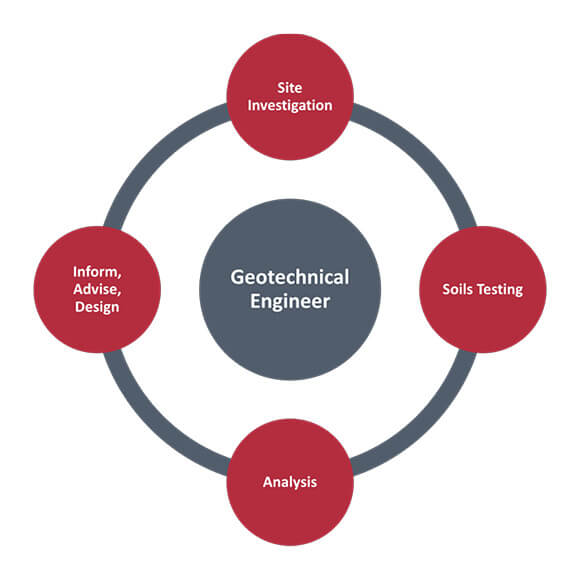Our Geotheta Diaries
Our Geotheta Diaries
Blog Article
Geotheta Can Be Fun For Everyone
Table of ContentsGeotheta Can Be Fun For AnyoneSome Known Questions About Geotheta.The Best Guide To Geotheta7 Simple Techniques For GeothetaSome Ideas on Geotheta You Need To Know

They conduct website examinations, gather samples, carry out laboratory tests, and evaluate information to review the suitability of the ground for building projects - Geo Tech Engineering. Based upon their searchings for, geotechnical designers offer recommendations for structure style, slope stability, retaining frameworks, and mitigation of geotechnical dangers. They collaborate with various other professionals, such as engineers, architectural designers, and building teams, to make sure that geotechnical considerations are incorporated right into the general project layout and execution
By evaluating the actions and residential properties of dirt and rock, they can recognize possible geotechnical risks such as landslides, dirt negotiation, or incline instability. Their know-how assists avoid failures or mishaps that might threaten lives and property. Below are some in-depth tasks and responsibilities of a geotechnical engineer: Website Investigation: Geotechnical engineers conduct site examinations to collect information on subsurface conditions.
They translate the data to understand the residential or commercial properties and actions of the dirt and rock, including their strength, leaks in the structure, compaction attributes, and groundwater conditions. Geotechnical Analysis and Design: Geotechnical engineers examine the information gathered during website investigations to evaluate the stability and viability of the site for construction tasks. They do geotechnical estimations and modeling to evaluate factors such as bearing ability, settlement, slope stability, lateral earth pressures, and groundwater circulation.
Excitement About Geotheta
Structure Layout: Geotechnical designers play an important function in creating structures that can safely support the designated framework. They analyze the dirt conditions and lots requirements to identify the suitable foundation kind, such as shallow structures (e.g., grounds), deep foundations (e.g (https://packersmovers.activeboard.com/t67151553/how-to-connect-canon-mg3620-printer-to-computer/?ts=1722609175&direction=prev&page=last#lastPostAnchor)., piles), or specialized techniques like soil renovation. They think about factors such as settlement limits, bearing capability, and soil-structure communication to establish optimum structure styles
They review building strategies, screen website activities, and perform area evaluations to validate that the style recommendations are complied with. If unanticipated geotechnical concerns arise, they assess the circumstance and provide recommendations for removal or modifications to the layout. Danger Analysis and Reduction: Geotechnical engineers evaluate geotechnical risks and dangers related to the project website, such as landslides, liquefaction, or dirt disintegration.

Cooperation and Communication: Geotechnical designers function closely with various other professionals associated with a project, such as engineers, architectural engineers, and building and construction teams. Reliable communication and cooperation are essential to integrate geotechnical considerations into the general task design and construction procedure. Geotechnical designers give technical proficiency, response inquiries, and guarantee that geotechnical requirements are satisfied.
Not known Factual Statements About Geotheta
Here are some kinds of geotechnical engineers: Foundation Engineer: Foundation designers focus on designing and assessing foundations for structures. They evaluate the dirt problems, tons requirements, and site features to establish one of the most appropriate foundation type and layout, such as shallow structures, deep foundations, or specialized strategies like stack structures.
They evaluate the aspects influencing slope stability, such as dirt buildings, groundwater conditions, and slope geometry, and create strategies to stop incline failures and alleviate threats. Earthquake Engineer: Quake designers focus on evaluating and developing structures to withstand seismic pressures. They analyze the seismic hazard of a site, review soil liquefaction potential, and create seismic style standards to make sure the safety and resilience of frameworks during quakes.
They carry out field screening, accumulate samples, and assess the collected data to define the soil buildings, geologic developments, and groundwater conditions at a website. Geotechnical Instrumentation Designer: Geotechnical instrumentation designers focus on tracking and measuring the actions of dirt, rock, and frameworks. They set up and keep instrumentation systems that monitor elements such as soil settlement, groundwater degrees, slope activities, and structural variations to examine performance and provide very early warnings of potential issues.
Fascination About Geotheta
They perform examinations such as triaxial examinations, debt consolidation examinations, straight shear tests, and permeability tests to collect information for geotechnical evaluation and layout. Geosynthetics Engineer: Geosynthetics designers specialize in the style and application of geosynthetic materials, such as geotextiles, geogrids, and geomembranes. They use these materials to boost soil stability, reinforce inclines, offer water drainage services, and control disintegration.
They tend to be investigatory people, which implies they're intellectual, introspective, and curious. They are curious, methodical, reasonable, logical, and sensible. Some of them are additionally social, indicating they're kind, charitable, participating, client, caring, handy, understanding, sensible, and pleasant - Engineer of Record.
In the office environment, geotechnical engineers make use of specialized software devices to execute estimations, develop layouts, and evaluate data. They prepare records, testimonial job specs, interact with clients and group participants, and coordinate job activities. The workplace setting offers a conducive setting for research study, analysis, and partnership with various other experts associated with the project.
The 9-Minute Rule for Geotheta
They frequently see job sites to carry out site investigations, evaluate geotechnical problems, and gather data for analysis. These brows through entail traveling to different locations, in some cases in remote or challenging terrains. Geotechnical engineers might perform soil sampling, conduct examinations, and display building and construction activities to make sure that the geotechnical facets of the job are being implemented appropriately.
Geotechnical engineers also function in go to this web-site specialized geotechnical research laboratories. Geotechnical research laboratory engineers function thoroughly in these settings, handling testing tools, operating tools, and taping data.
Report this page